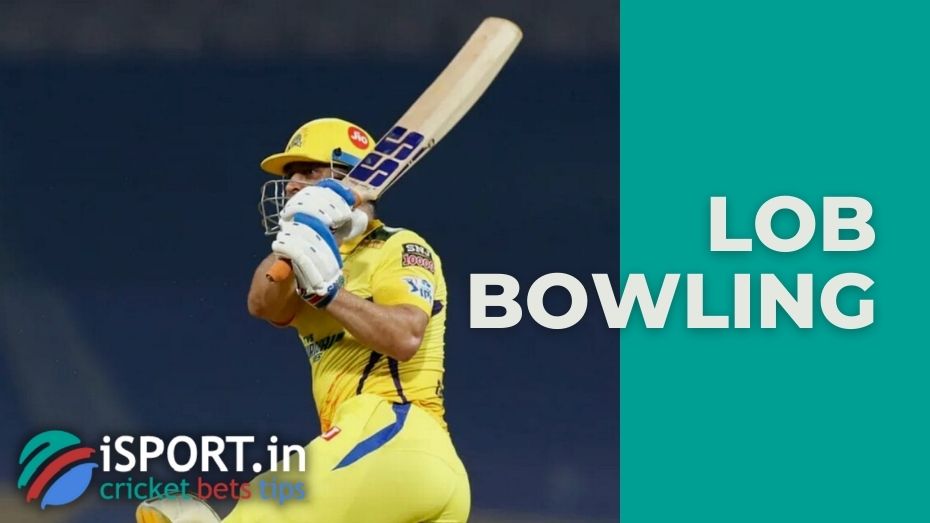Lob bowling

Lob bowling is a type of Underarm bowling, an attacking technique that is practically not found in modern cricket. Also known as Donkey drop.
History and Features of Lob Bowling
When playing lob bowling, the player lowers his hand substantially lower than the typical serve height that is permitted by Laws. This causes the ball to go upward in an arc, which is the primary characteristic of lob bowling. The Donkey drop is a technique that, when done correctly, enables you to demolish the wicket with a single stroke. However, in the majority of instances, the projectile travels behind the batsman’s back to a crease.
Currently, the most common places to witness lob bowling are in provincial and children’s events. These are the types of competitions where the regulations are more relaxed than those at professional championships. On the other hand, this was not always the case. In addition, it was underarm bowling and the many variations of the game that established the standard for the whole game in its early phases of growth.
This was partly due to the fact that the condition of the playgrounds in the XVIII-XIX centuries left much to be desired since they were used for playing only occasionally; the rest of the time, they could graze sheep or break horses. As a consequence of the uneven surface of the pitch, bowlers were able to get ideal outcomes by rolling the ball low. This was possible since even the most skilled hitters were unable to properly anticipate the direction in which the ball would go.
Lob Bowling: Controversy
Early editions of the Laws did not actually restrict bowlers in choosing the method of bowling. Moreover, the first attempts of the players to abandon Underarm bowling in general and Lob bowling, in particular, were not understood by either the public or the organizers of the competition, and moreover by rivals who saw in the Roundarm a violation of age-old traditions.
The first edits to the relevant Laws section were made in 1845, but more than a hundred years passed before Lob bowling was actually banned. The incident involving underarm bowling that took place during the one-day match between Australia and New Zealand in 1981 served as the catalyst for this decision.
Lob Bowling: Current Rules and Cricket Ethics
On the last over, there was only one ball left to play, which New Zealand was obliged to win in order to bring the score to victory. Australian captain Greg Chappell asked the bowler (his younger brother Trevor) to perform an Underarm-style serve to force batsman Brian McKechnie to play from the defense. Although Australia emerged victorious in the match, the last event sparked a furious outburst of anger among the spectators. Following a number of discussions among the relevant authorities, it was determined to add a number of amendments to the Laws (article No ball), namely the following:
21.1. Mode of delivery.
21.1.1. The umpire shall ascertain whether the bowler intends to bowl right handed or left handed, over or round the wicket, and shall so inform the striker. It is unfair if the bowler fails to notify the umpire of a change in his/her mode of delivery. In this case, the umpire shall call and signal No ball.
21.1.2. Underarm bowling shall not be permitted except by special agreement before the match.
21.1.3. Fair delivery is a hand. The delivery is considered completed according to the rules if the hand was indirect. In order not to violate this rule, one should raise the arm to shoulder level, while the elbow joint should not straighten (partially or completely) until the ball leaves the palm; however, flexion and rotation of the wrist are allowed.
The umpire, who is next to the striker, determines whether the delivery was made honestly. If he decides that the player straightened his arm, he has the right to declare No ball.
21.3. Ball thrown or delivered underarm – action by umpires.
21.3.1. If the umpire recorded a delivery that was not carried out according to the rules, then he should declare No ball and then inform the second umpire about the reason for his decision. In such a situation, the umpire, who is on the bowler’s end, is obliged to:
- Give the bowler the first and last warning, which will be valid throughout the entire innings;
- Inform the captain of the field team about the reason for his decision;
- Inform the batsmen at the wicket about the essence of what happened.
The rule that prohibits Lob bowling is followed very strictly. So, in particular, if the bowler again serves low after the first warning is issued, then the umpire suspends him for the whole inning.
This is interesting: it is believed that Lob bowling is incompatible with Spirit of cricket because, with the help of this pitch, the bowler does not just send the batsman out but also does it in the most offensive way for the latter. In this sense, Lob bowling can be compared to a Panenka in football – a “scoop” kick, which got its name in honor of Czechoslovak midfielder Antonin Panenka.
